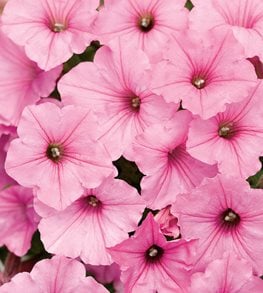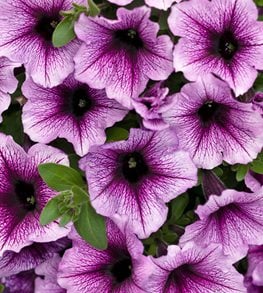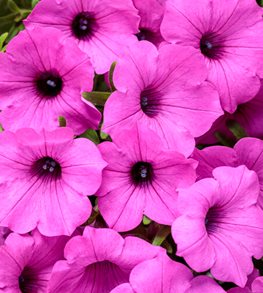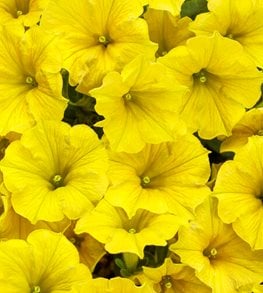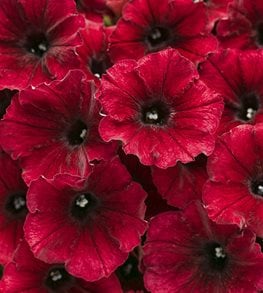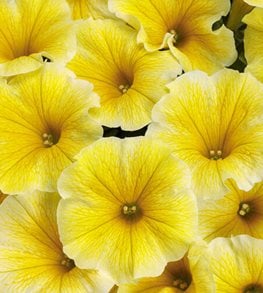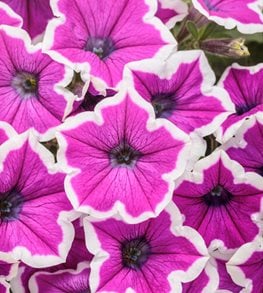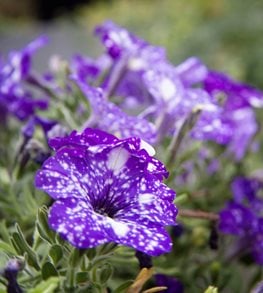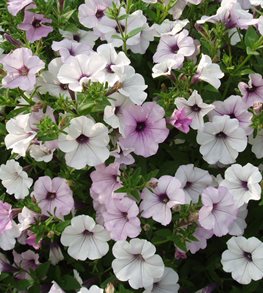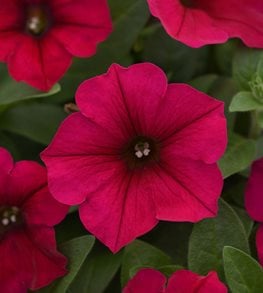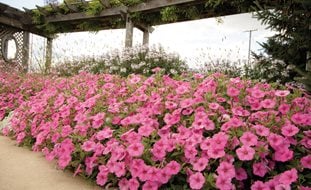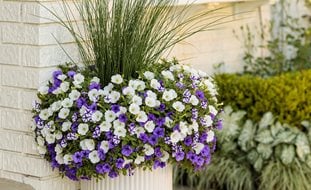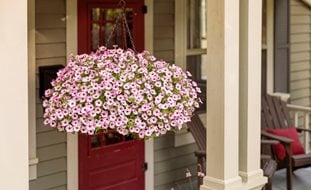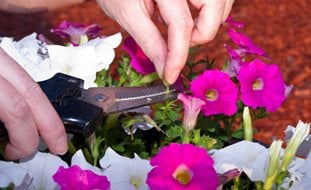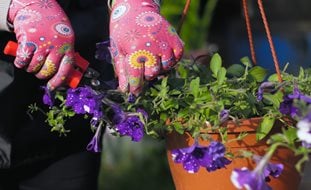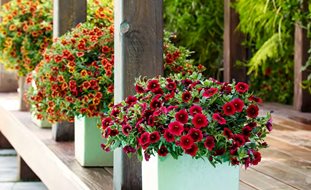How to Grow & Care for Petunias: Planting, Feeding & Bloom-Boosting Tips
A complete guide to planting, watering, feeding, pruning, and troubleshooting petunias for nonstop blooms.
Supertunia Vista® Bubblegum®. Photo by: Proven Winners
Quick-Start Checklist- Full sun: 6-8 hours daily
- Water: Keep soil evenly moist, well-drained
- Fertilize: Slow-release at planting + weekly liquid fertilizer in summer
- Prune: Trim back 1/3 when leggy to encourage rebloom
- Deadhead: Remove spent blooms on non-self-cleaning varieties (Supertunias self-clean)
- Watch for budworms: Tiny caterpillars hollow out buds and stop flowering. See our budworm guide.
Petunias have long been a favorite for sunny flower beds, hanging baskets, and containers. Thanks to modern breeding, they now come in more colors, patterns, and growth habits than ever before — and newer hybrids thrive with minimal effort.
Whether you prefer compact varieties for a tidy border or trailing types to spill over baskets, following these tips will keep your plants vibrant from spring to frost.
Keep your petunias blooming all summer with these 4 tips.
2025 Annual of the Year:
Supertunia Mini Vista® Yellow petunia.
On this page: Basics | Planting | Care | Petunia Varieties | Design Ideas | FAQs
On this page:
- BASICS
- TYPES OF PETUNIAS
- PLANTING PETUNIAS
- PETUNIA CARE & MAINTENACE
- PETUNIA PICTURES
- DESIGN IDEAS
- FREQUENTLY ASKED QUESTIONS
BASICS
Plant type:
Tender perennial, typically grown as an annual
Zones:
9-11
Exposure:
Full sun, 6-8 hours daily
Bloom time:
Late spring until frost
Height/spread:
6 to 8 inches tall, 12 to 48 inches spread; varies depending on the variety
Flower color and characteristics:
Available in nearly every color, including black; with single or double blooms, ruffled or smooth edges, and patterns from stripes to speckles.
TYPES OF PETUNIAS
Petunias are often grouped by bloom size and growth habit:
- Grandiflora petunias: Large, showy flowers (up to 5 in.) but more delicate in rain; best for containers and sheltered areas.
- Multiflora petunias: Smaller flowers but very weather-tolerant; great for garden beds and mass plantings.
- Milliflora petunias: Compact plants with miniature, nonstop flowers; perfect for edging and small pots.
For more on the different types of petunias, see our petunia variety guide.
HOW TO PLANT PETUNIAS
When to plant:
In spring, after all danger of frost has passed.
Where to plant:
Choose a location with full sun. While petunias will tolerate light shade, they'll bloom best in bright conditions.
Soil:
Light, fertile, well-drained, slightly acidic (pH 6.0-6.5) soil is ideal. Amend clay soils with compost or organic matter.
Container planting:
Use a high-quality, free-draining potting mix with slow-release fertilizer. Ensure pots have drain holes.
Grow petunias from seed:
Start seeds indoors 8-10 weeks before the last frost. Petunia seeds are tiny and slow to germinate. Sow seeds on the soil surface and keep moist until germination. Transplant them out once the soil warms up.
PETUNIA CARE
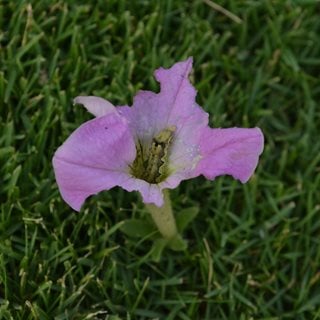
Budworm inside a petunia flower. Photo by: Bhupinder Bagga / Shutterstock
Water:
Petunias have shallow roots that dry out quickly. Water in-ground plants deeply 1-3 times per week. Petunias in containers may need daily watering in hot weather.
Fertilizing:
Add a slow-release fertilizer at the time of planting. Fertilize weekly in hot climates (or every 3rd watering in milder climates) with a water-soluble bloom booster during summer. Plants in containers often need more frequent fertilizing because the nutrients get washed out quicker. Avoid high-nitrogen fertilizers; they promote foliage over flowers.
Pruning and deadheading:
The amount of pruning required often depends on the variety you’re growing.
- Traditional grandifloras: Deadhead frequently.
- Self-cleaning and spreading varieties: Occasional deadheading for fuller plants.
- If plants get leggy and have fewer blooms, cut back by up to 1/3; follow with fertilizer for a bloom flush.
For more, see: How to Deadhead Petunias and How to Prune Petunias.
Pests and diseases:
Petunias can be bothered by pests like aphids, thrips, and mites; as well as powdery mildew.
Budworms are the leading cause of sudden bloom loss. The small caterpillars hollow out buds from the inside, so flowers never open. Inspect buds often and treat promptly. See our budworm control guide for petunias.
“People underestimate just how much of a heavy feeder a petunia can be. I like to keep on a schedule of one time per week with a water-soluble fertilizer…usually the ones with bloom boosters. They tend to have the nutrients that petunias like to produce more flowers.”
— 5 Tips for Better Petunias, Corey, Up North Garden with Corey, YouTube channel.
PETUNIA VARIETIES
(with Supertunias!)
From Heidi Grasman, Garden Crossings
IDEAS FOR USING PETUNIAS IN THE LANDSCAPE
Petunias are very popular flowers for adding instant color to a garden. They are incredibly versatile and can be used in many ways. Here are some ideas:
- Plant them as colorful additions to seasonal landscape beds
- Grow them individually in hanging baskets and window boxes or along with other strong growers
- Use them in containers as the filler or spiller component
- Plant petunias in masses for a dramatic blanket of color
- Cover bare spots in your garden quickly and prevent weeds
FREQUENTLY ASKED QUESTIONS
Do deer eat petunias?
Yes, deer do eat petunias, especially when other food is scarce. If deer visit your garden, consider protecting your petunias with repellents or fencing. Learn more on how to protect your garden from deer.
Do rabbits eat petunias?
Yes, rabbits like to eat petunias. If you have rabbits around, protect your petunias with barriers or natural repellents to keep them safe. See more natural ways to protect your garden from rabbits.
Are petunias poisonous to dogs or cats?
Not to worry—petunias are safe for dogs and cats. However, it's always best to discourage them from eating any plants to prevent any possible stomach upset.
Do petunias need full sun?
Petunias love sunshine and grow best in full sun (6-8 hours a day). Planting them in a sunny spot ensures they stay healthy and full of blooms. They can tolerate some shade, but just might have fewer flowers.
Do hummingbirds like petunias?
Yes, the bright colors and funnel-shaped flowers make them appealing to hummingbirds. See more flowers for hummingbirds.
Why did my petunias stop blooming?
Usually due to a lack of sun, nutrients, or budworm damage. See our guide on how to keep your petunias blooming.
MORE ON PETUNIAS
ABOUT THE AUTHOR
Anne Balogh is a longtime gardening writer and editor for Garden Design, with over 20 years of experience covering everything from container planting to landscape trends. She draws inspiration from her own Zone 5 garden in Illinois, where she experiments with hardy perennials and flowering annuals.

